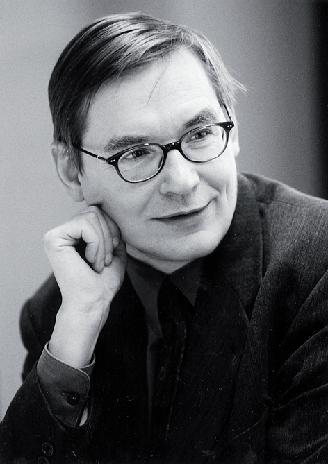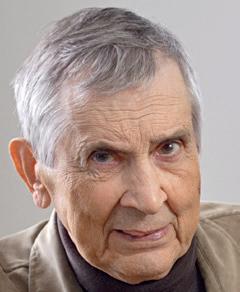
6 minute read
Kalevi Aho on a new threshold
At Kalevi Aho´s composer workshop in idyllic Käpylä, a district of Helsinki, new works are born at a steadily fast pace by means of a substantial dose of intuitive imagination and rigorous routine, as well as good old-fashioned craftmanship. For Aho, the coming year will probably mean that some extra public attention is just round the corner, but he himself admits that he has never been particularly fond of jubilees.
Kalevi Aho is on a new threshold to his fourth quarter of a century: he will be 75 in March 2024. But he won´t hear of any pleasantly peaceful pensioner´s life or, for that matter, any excessive celebrating. For Aho composing is as natural as breathing, and seldom does a day go by without his writing down notes. Except, possibly, when he is travelling to attend one of his premieres. And when it comes to premieres, quite a few accumulate during just one year. Usually about ve new works – not counting minor pieces for various occasions, arrangements and adaptations – are created during an average year, and Aho has no intention of slowing down. Typically, he has commissions booked two years or so ahead, and as soon as one work is nished he immediately starts on the next.
A normal workday for Aho is generally divided into two (for the most part) working periods, one during the day and one during the evening, with for example a walk in the woods as a well-deserved breather in between. Aho is one of the last of the Mohicans not to use digital aids in his compositional work, and an explanation for his proli c productivity is that he has a decidedly intuitive manner of composing.
He never makes sketches, the score rather develops in its entirety by means of pencil and eraser, bar by bar –usually 2-4 pages in a workday – nor does he revise his works. What is written is written, and that is what it was intended to be.
In other words, a compositional craft that in our time is rare, and a working method which of course requires enormous professional skill, as well as a considerable degree of sheer routine. e dramaturgical and formal aspects are established in parallel with the sonorous, harmonic and rhythmical structures, and the instrumentation is an indispensable part of the compositional process itself.
A great day for chamber music
Needless to say, this also holds true for the Symphony No. 18, a work which Aho will be putting the nishing touches soon. is work commissioned by Saimaa Sinfonietta is rst in line among the jubilee year´s premieres with performances in Mikkeli and Lappeenranta in February 2024.
Besides numerous other performances of Aho´s works and a recording of his Symphony No. 17 in Lahti, two additional premieres are de nitively scheduled for the year 2024: in April a Double Concerto for Violin and Cello in Oulu, Finland and in August a Trio for the unusual medium of accordion, double bass and percussion.
Kalevi Aho’s birthday, on the 9th of March, will then be celebrated in the spirit of chamber music with a concert at the Helsinki Music Centre as part of the chamber music series of the Finnish Radio Symphony Orchestra. Yet Aho is de nitely a man of the orchestra and his favourite genre, besides the symphony, is the solo concerto. We count to date no less than 39 concertos by him. And as a curiosity it can be mentioned that no less than four such works – a concerto for piccolo clarinet, one for alto ute, a double concerto for ute and harp, and one for viola and percussion – were premiered during a mere month and a half in the spring of 2022.
e recent premiere, a Baritone Horn Concerto, took place in early June in Kotka, while String Quartet No. 4 will be heard for the rst time a few weeks later, soon after Aho´s own festival, Musica Kalevi Aho, in his hometown Forssa. Even a fth string quartet is awaiting its premiere, while a concerto for kantele and strings and a fourth accordion sonata (for an accordion with quarter-tone intervals) are high on the list of commissions.
Every year a jubilee year
Furthermore, in the autumn, just in time for the Helsinki Book Fair, the biography Kalevi Ahon elämää ja tekoja (Kalevi Aho’s Life and Works), written by his childhood friend Hannu Lahtonen, will be published in Finnish. It is really not a question of a traditional type of life story with accompanying in-depth analyses of the compositions, but the emphasis will primarily be on how the works came to be and how they were received.
Kalevi Aho is thus on the threshold of his life´s fourth quarter of a century, at the same time as 57 years have elapsed since his (in actuality) rst opus, String Quartet No. 1, appeared (Aho composed it when he was 18 years old). He has not given his works opus numbers, but if he had done so the number for Symphony No. 18 would be somewhere around 220. For all that, Aho has never been a scribbler who churns out heaps of pieces just for the sake of it, rather for him composing is an indispensable part of daily life with its need for expression. Even though every artist naturally thirsts for attention in some form, Aho willingly admits that he is not especially fond of jubilee years or unnecessary celebrating in general. For him, every year is a jubilee year or, if you will, a working year. And every day in the composer workshop means seconds of unique music waiting to reach the listeners´ ears and, at best, to utterly move them.




Mats Liljeroos
GUNNAR DE FRUMERIE
Circulus Quintus (1965) Dur: 60´
The pedagogically-conceived Circulus Quintus consists of 24 exquisitely varied, romantic character pieces in all keys. This music is permeated by a feeling of lightness, playfulness and fantasy. Here we find inspiration from Baroque dances like Gavotte and Saraband, as well as from folk-music idioms. Also, there are pieces that are more evocative of moods such as Nocturne and Pastoral.
MIKKO HEINIÖ
April Evenings for Black
Twins – Sonata for two pianos (2015) Dur: 15’
A virtuoso piece in five movements of timbral and rhythmic pleasure, in true Heiniö fashion. The world of sound is sumptuously colourful and the steady pulse and drive reflect Heiniö’s love of running. The division between two equal piano parts is so skilfully done that the overall effect is of one big instrument.
EINOJUHANI RAUTAVAARA


ARR. PETER LÖNNQVIST



Cantus arcticus – Duet for Birds and Piano (1972/2012)
Dur: 18’
This transcription for piano of the work by Rautavaara most often performed enables pianists to immerse themselves in the magical world of the Cantus arcticus. It admirably captures the essence of the colourfully impressionistic harmonies and warmly romantic melancholy. The bird soundtrack can be downloaded.
HEIKKI SARMANTO
Impressions de Paris / Paris
Impressions (2003) Dur: ca 67’
20 pieces for piano dedicated to French chansonnier Allain Leprest. Their charming sound is like a declaration of love to Paris. The jazzy suite represents Sarmanto’s piano music at its very best, with its intoxicating, nostalgic melodies. He wrote the Impressions while living in Paris, and themes inspired by the city alternate with improvised variations and yet more melodies.
ALBERT SCHNELZER
Playground (2021) Dur: 15´
Five challenging pieces focusing on playfulness. In the first Debussy meets the cartoon character Bart Simpson; in the second Bach meets Prokofiev, when the right and the left hand are playing tag. The slow third movement is a meditation on how children see magic in everything; the fourth takes us on an adventurous merry-go-round ride; and finally, in the fifth movement, there is a chase after horrible Goblins who love to dance.
MARTIN SKAFTE

12 Preludes – book one (2012/13) Dur: 29’
12 Preludes – book two (2015/17) Dur: 32’
Inspired by Debussy, Skafte exploits the colours and sonorities of the piano but also requires Lisztian virtuosity and pulls in a range of further influences, among them ragtime and Ligeti. A sly sense of humour can often be detected in the background.
BENJAMIN STAERN
Dropwaves (2016/17) Dur: 15´
An overwhelming, exuberantly constructed piano sonata in three movements which playfully surges and gushes forth. There are also idle, meditative sections in which Staern makes use of e-bows to create bourdon tones. Composed in memory of Olivier Messiaen and dedicated to pianist David Huang.
STAFFAN STORM
Lied vom Meer (2009) Dur: 15’
Piano suite in four movements based on Rilke’s poem Lied vom Meer. The work’s form and melodic patterns follow those of the poem. Storm describes this as a musical reading of the text. The music has an impressionistic tinge, especially in the exquisite final movement … im Mondschein… where Storm lets the melodies and harmonies flow; but he ends in the sea, black as night, in the lowest register of the piano, rumbling softly.
MATTHEW WHITTALL
Leaves of Grass (2005-09)
Dur: ca 63’
In these 12 preludes inspired by Walt Whitman’s verses, the piano sings in a fascinating way. The music reflects composers which Whittall has admired: there are heroic arpeggios reminiscent of Chopin seen through a pop-minimalist prism or clangorous white-key chords familiar from Debussy. The pieces are brilliant examples of Whittall’s colourful imagination and originality. They can be performed as a grand, one-hour suite or on their own or in any selections.
VICTORIA YAGLING
Autumn Diary (2003) Dur: ca 8’
A richly colourful suite of wistful, pungent autumnal tones. More tranquil movements tinged with singing melancholy alternate with faster ones. The piano writing is both mellow and translucent, and it seems to spring naturally from the very depths of romanticism, even in the most challenging sections.




